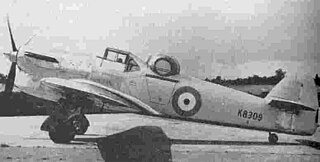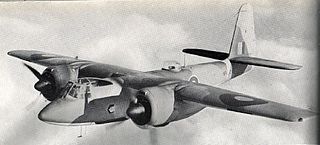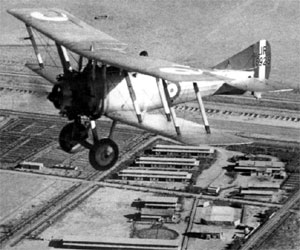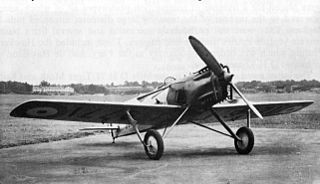Design and development
Gloster had designed a twin-engined turret-fighter for specification F.34/35 but the single-engined Boulton Paul Defiant for F.9/35 was seen to cover both requirements and the F.34/35 design dropped. Less than two years later, F.9/37 for a "twin-engined single-seat fighter with fixed armament" was issued. The F.9/37 was designed under the direction of George Carter, his first for Gloster, to F.9/37 (hence the name) as a single-seat fighter carrying an armament of four 0.303 in (7.7 mm) Browning machine guns and two 20 mm Hispano cannon in the nose. Intended for dispersed production by semi-skilled labour, the structure broke down into sub-assemblies.
A prototype (military serial L7999) with 1,060 hp Bristol Taurus T-S(a) radial engines flew on 3 April 1939 and demonstrated excellent performance, its maximum speed of 360 mph (580 km/h) being the best recorded by a British fighter at the time. Test flights revealed that the prototype was very manoeuvrable and "a delight to fly". After being badly damaged in a landing accident in July 1939, it was re-engined with 900 hp Taurus T-S(a)-IIIs in 1940, which reduced its performance. A second prototype (L8002) with 880 hp Rolls-Royce Peregrine I liquid-cooled, inline engines flew on 22 February 1940; it proved capable of 330 mph (530 km/h) at 15,000 ft (4,600 m).
F.18/40 and F.29/40
Specification F.18/40, for a specialist night fighter, with nose- and turret-mounted guns, led to Gloster submitting a design based on the F.9/37, fitted with Rolls-Royce Merlin engines, a dorsal four-gun turret and Airborne Interception (AI) radar. This received support from the Air Staff who saw it as superior to the Bristol Beaufighter and the Air Ministry ordered one of the F.9/37 prototypes to be converted to the new specification as F.29/40. Unofficially known as the Gloster Reaper, it inherited the admirable handling characteristics of the F.9/37 and despite being judged superior to other designs, including turreted variants of the Beaufighter and de Havilland Mosquito, the Reaper was terminated in May 1941, for Gloster to concentrate on other work, especially the Gloster E.28/39 jet aircraft.

The Bristol Type 156 Beaufighter was a multi-role aircraft developed during the Second World War by the Bristol Aeroplane Company in the UK. It was originally conceived as a heavy fighter variant of the Bristol Beaufort torpedo bomber. The Beaufighter proved to be an effective night fighter, which came into service with the Royal Air Force (RAF) during the Battle of Britain, its large size allowing it to carry heavy armament and early airborne interception radar without major performance penalties.

The Blackburn B-24 Skua was a carrier-based low-wing, two-seater, single-radial engine aircraft operated by the British Fleet Air Arm which combined the functions of a dive bomber and fighter. It was designed in the mid-1930s and saw service in the early part of the Second World War. It took its name from the sea bird.

The Bristol Type 163 Buckingham was a British Second World War medium bomber for the Royal Air Force (RAF). Overtaken by events, it was built in small numbers, and was used primarily for transport and liaison duties.

The Hawker Tornado was a British single-seat fighter aircraft design of World War II for the Royal Air Force as a replacement for the Hawker Hurricane. The planned production of Tornados was cancelled after the engine it was designed to use, the Rolls-Royce Vulture, proved unreliable in service. A parallel airframe that used the Napier Sabre engine continued into production as the Hawker Typhoon.

The Hawker Henley was a British two-seat target tug derived from the Hawker Hurricane that was operated by the Royal Air Force during the Second World War.

The Hawker Hotspur was a Hawker Henley redesigned to take a Boulton-Paul semi-powered four gun turret. It was designed in response to Air Ministry Specification F.9/35, which required a powered turret as the main armament to replace the Hawker Demon.

The Hawker Woodcock was a British single-seat fighter built by the Hawker Engineering Company as the first fighter to be produced by Hawker Engineering. It was used by the RAF as a night fighter in the 1920s.

The Gloster Gauntlet was a British single-seat biplane fighter of the RAF, designed and built by Gloster Aircraft in the 1930s. It was the last RAF fighter to have an open cockpit and the penultimate biplane fighter in service.

The Hawker Hawfinch was a British single-engined biplane fighter of the 1920s. It was unsuccessful, with the Bristol Bulldog being selected instead.

The Miles M.33 Monitor was a twin-engined British target tug aircraft designed and built by Miles Aircraft towards the end of the Second World War. Intended for use by the Royal Air Force and the Fleet Air Arm, the aircraft did not enter service with either.

The Westland C.O.W. Gun Fighter was an attempt to produce a fighter aircraft armed with a heavy calibre gun. The Coventry Ordnance Works (COW) 37 mm automatic gun was used, which had been developed for this purpose some years earlier.

The Blackburn B.26 Botha was a British four-seat reconnaissance and torpedo bomber. It was built by Blackburn Aircraft at its factories at Brough and Dumbarton, as a competitor to the Bristol Beaufort, entering service with the RAF in 1939. The design was underpowered and it was quickly withdrawn from operations.

The Boulton Paul P.92 was a British design by Boulton Paul for a two-seat, turret-armed, twin-engine heavy fighter and ground attack aircraft to meet Air Ministry Specification F.11/37. Only a half scale prototype – the P.92/2 – was built and tested as check on aerodynamics before the project was cancelled in 1940.

The Gloster F.5/34 was a British fighter of the 1930s. It was a single-seat, single-engine monoplane of all-metal cantilever construction; the undercarriage was of the tailwheel type with retractable main wheels.

The Gloster SS.35 Gnatsnapper was a British naval biplane fighter design of the late 1920s. Two prototypes were built but the type did not enter production.

The Bristol Bloodhound was a British two-seat reconnaissance/fighter aircraft designed and built by the Bristol Aeroplane Company as a possible replacement for the Bristol F.2 Fighter for the Royal Air Force. It was unsuccessful, only four prototypes being built.

The Nieuport Nighthawk was a British fighter aircraft developed by the Nieuport & General Aircraft company for the Royal Air Force towards the end of the First World War. Although ordered into production before the aircraft first flew, it did not enter large scale service with the RAF owing to unreliable engines. Re-engined aircraft did see service in Greece, serving from 1923 to 1938.

The Bristol Type 146 was a British single-seat, eight-gun fighter monoplane prototype built to a mid-1930s Air Ministry contract. Powered by a radial engine, it was outclassed by Merlin-engined fighters and only one was built.

The de Havilland DH.77 was a prototype British fighter aircraft of the late 1920s. Intended as a fast climbing interceptor for Britain's Royal Air Force, the DH.77 was a lightweight low-wing monoplane powered by a relatively low power engine. Despite excellent performance, only one aircraft was built, the Hawker Fury biplane being preferred.
The Blackburn F3 was a British single-engined fighter aircraft produced in response to Air Ministry Specification F.7/30.
This page is based on this
Wikipedia article Text is available under the
CC BY-SA 4.0 license; additional terms may apply.
Images, videos and audio are available under their respective licenses.



















